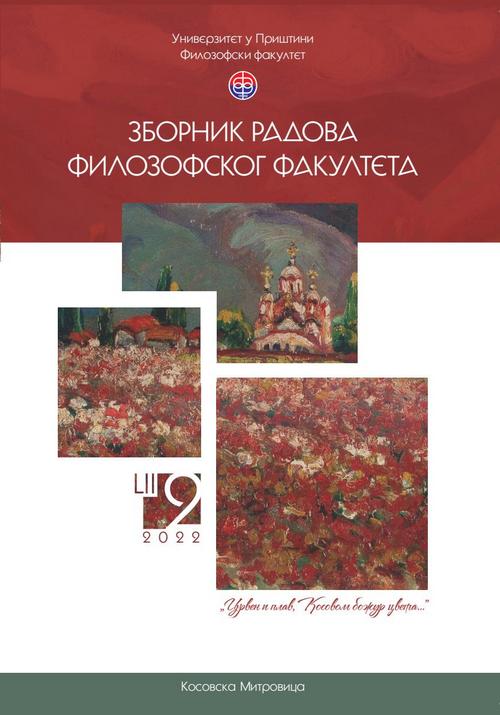Немци у Војводини у периоду оснивања Краљевине СХС: интердисциплинарни приступ
Sažetak
Рад се бави интердисциплинарном анализом процеса интеграције немачке етничке мањине и конструкције немачког идентитета у историјском контексту прве југословенске државе, Краљевине Срба, Хрвата и Словенаца (1918–1929). Као значајан фактор очувања немачког идентитета 1920. године основан је Швапско-немачки културни савез – Културбунд, који је, иако не без сметњи у свом раду, представљао окосницу културних пракси и окупљања немачке заједнице током целокупног међуратног периода, а примарно је деловао на подручју Војводине. Анализа уважава теоријски модел етничких граница Фредерика Барта у оквиру интеракционистичког приступа проучавања етницитета, у настојању да се поближе расветли начин на који се немачки идентитет у том периоду градио у релацији са другим групама, али приказане су и основне промене које су се одвијале на макро нивоу друштвене структуре.
Reference
Антоловић, М. (2013). „Пангерманска аждаја“ и „Змија у недрима“ – српско-хрватски дискурс о Немцима на јужнословенским просторима почетком 20. века. У: С. Марковић (ур.), Друштвени односи Срба и Хрвата, национални идентитет и мањинска права са аспекта европских интеграција, књ. 2 (9–22). Сомбор: Педагошки факултет.
Антоловић, М. (2017). Немачка мањина у Војводини (1918–1941) – друштво и политика. Сомбор: Педагошки факултет.
Бешлин, Б. (2006). Насељавање Немаца у Војводини. Нови Сад: Платонеум.
Вебер, М. (1976). Привреда и друштво I–II. Београд: Просвета.
Јањетовић, З. (2008). Непролазна свакодневица: Немачки допринос народној култури Војводине. Токови историје, 3–4, 214–224.
Јањетовић, З. (2009). Српски утицаји на свакодневну културу Немаца у Војводини. Годишњак за друштвену историју, 2, 19–33.
Крел, А. (2008). Улога удружења „Герхард“ у ревитализацији етничког идентитета сомборских Немаца. У: З. Дивац (ур.), Слике културе некад и сад (155–167). Београд: Етнографски институт САНУ.
Крел, А. (2009). Ревитализација етничког идентитета Немаца у Сремским Карловцима. Гласник Етнографског института САНУ, LVII (1), 71–92.
Крел, А. (2010). „Немачко удружење Адам Беренц“ и ревитализација немачког идентитета Немаца у Апатину. Етноантролошки проблеми, 5 (2), 165–180.
Крел, А. (2014). Немачко удружење Велики Бечкерек: Генератор ревитализације немства у Зрењанину. Етнолошко-антрополошке свеске, 24 (13), 25–44.
Крел, А. (2015). Немци поново у Гакову: сусрети, страдања и помирење некадашњег и садашњег локалног становништва. Гласник Етнографског института САНУ, 63 (2), 283–301.
Марковић, С. (2020). Од присаједињења до прекрајања: Војводина у Краљевини СХС / Југославији 1918–1941. Нови Сад: Архив Војводине.
Павлица, Б. (2005). Судбина Немаца у Србији. Теме, 29 (3), 351–392.
Прелић, М. (2005). Неки проблеми истраживања етницитета/етничког идентитета у културној антропологији. У: Д. Радојичић (ур.), Етнологија и антропологија: стање и перспективе (199–207). Београд: Етнографски институт САНУ.
Bakić, J. (2006). Teorijsko-istraživački pristupi etničkoj vezanosti (Ethnicity), nacionalizmu i naciji. Sociologija, 48 (3), 231–265.
Balaša, V. (2009). Apatinski Nemci: Etnička revitalizacija jedne skrivene manjine. Antropologija, 8, 129–144.
Bart, F. (1997). Etničke grupe i njihove granice. U: F. Putinja i Ž. Stref-Fenar (prir.), Teorije o etnicitetu. Beograd: Biblioteka XX vek.
Bešlin, B. (2001). Vesnik tragedije. Nemačka štampau Vojvodini 1933–1941 godine. Novi Sad: Platoneum.
Ćetković, N. i Sinđelić-Ibrajter, S. (2000). Dunavske Švabice. Beograd: Medijska knjižara Krug.
Dženkins, R. (2001). Etnicitet u novom ključu. Beograd: Bibliteka XX vek.
Đordano, K. (2001). Ogledi o interkulturnoj komunikaciji. Beograd: Biblioteka XX vek.
Eriksen, T. H. (2004). Etnicitet i nacionalizam. Beograd: Biblioteka XX vek.
Gramši, A. (2012). Hegemonija, intelektualci i država. U: J. Đorđević (prir.), Studije kulture (148–154). Beograd: Službeni glasnik.
Janjetović, Z. (2004). Švabe u Vojvodini. U: B. Sikimić (ur.), Skrivene manjine na Balkanu (121–134). Beograd: Institut za balkanske studije.
Janjetović, Z. (2005). Deca careva, pastorčad kraljeva. Beograd: INIS.
Janjetović, Z. (2009). Nemci u Vojvodini. Beograd: INIS.
Janjetović, Z. (2016). Jugoslovenska politika prema manjinama između dva svetska rata. U: K. Glas i dr. (prir.), O „nestanku“ nemačkih nacionalnih manjina: jedno teško poglavlje u istoriji Jugoslavije, 1941–1955. godine (22–32). Ulm: Centralni podunavskošvapski muzej.
Koković, D. i Ristić, D. (2012). Kulturne razlike, etničke granice i etnička distanca: istraživanja u Vojvodini. Teme, 36 (4), 1507–1534.
Krel, A. (2014). Време прикривања: идентитетска стратегија свесног трајног одбацивања и/или привременог прикривања етничког идентитета Немаца у Банату у другој половини 20. века. Antropologija, 14 (2), 89–100.
Lamont, M. & Molnar, V. (2002). The Study of Boundaries in the Social Sciences. Annual Review of Sociology, 28, 167–195.
Lazar, Ž. (Ed.) (2007). Vojvodina amidst Multiculturality and Regionalization. Novi Sad: Mediterran Publishing.
Malešević, S. (2009). Sociologija etniciteta. Beograd: Fabrika knjiga.
Putinja, F. i Stref-Fenar, Ž. (1997). Teorije o etnicitetu. Beograd: Biblioteka XX vek.
Rill, H. i Stojčić, M. (2015). Na tragu Podunavskih Nemaca u Vojvodini. Beograd: Centar za nenasilnu akciju.
Detalji u vezi sa uređivačkom politikom, uključujući i autorska prava, dostupni su na sajtu SCIndeks.
http://scindeks.ceon.rs/journalDetails.aspx?issn=0354-3293

